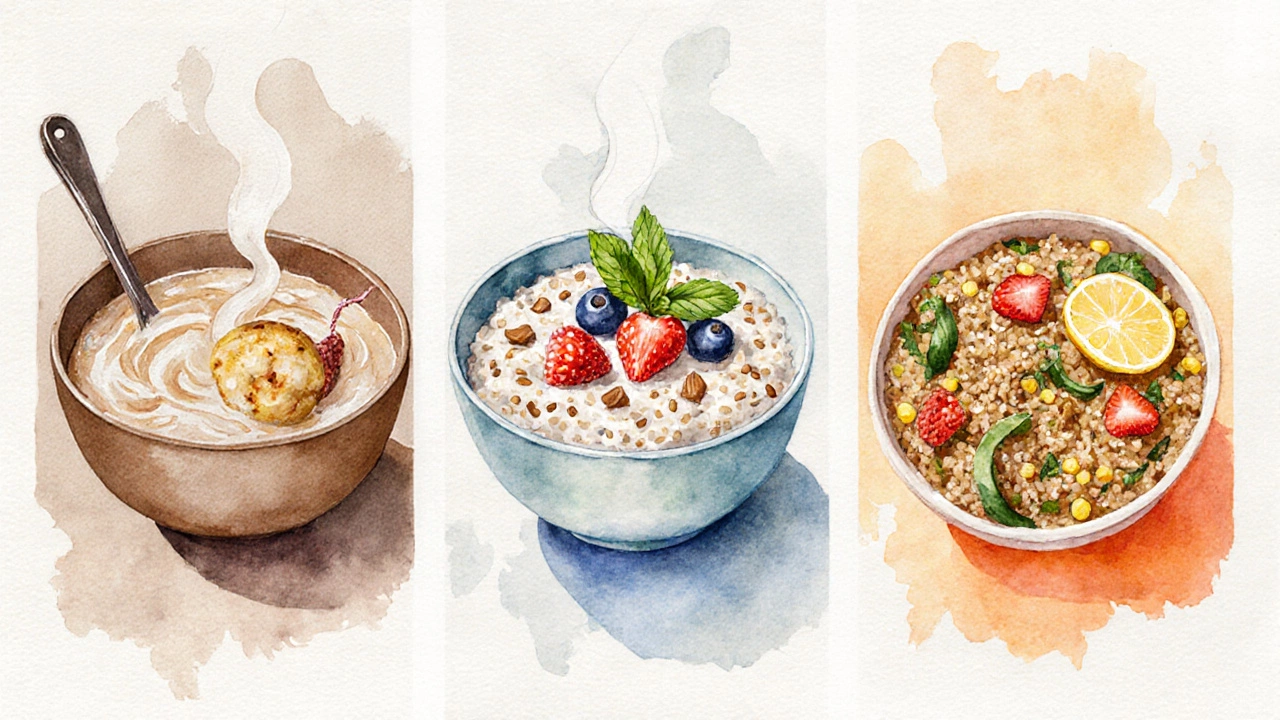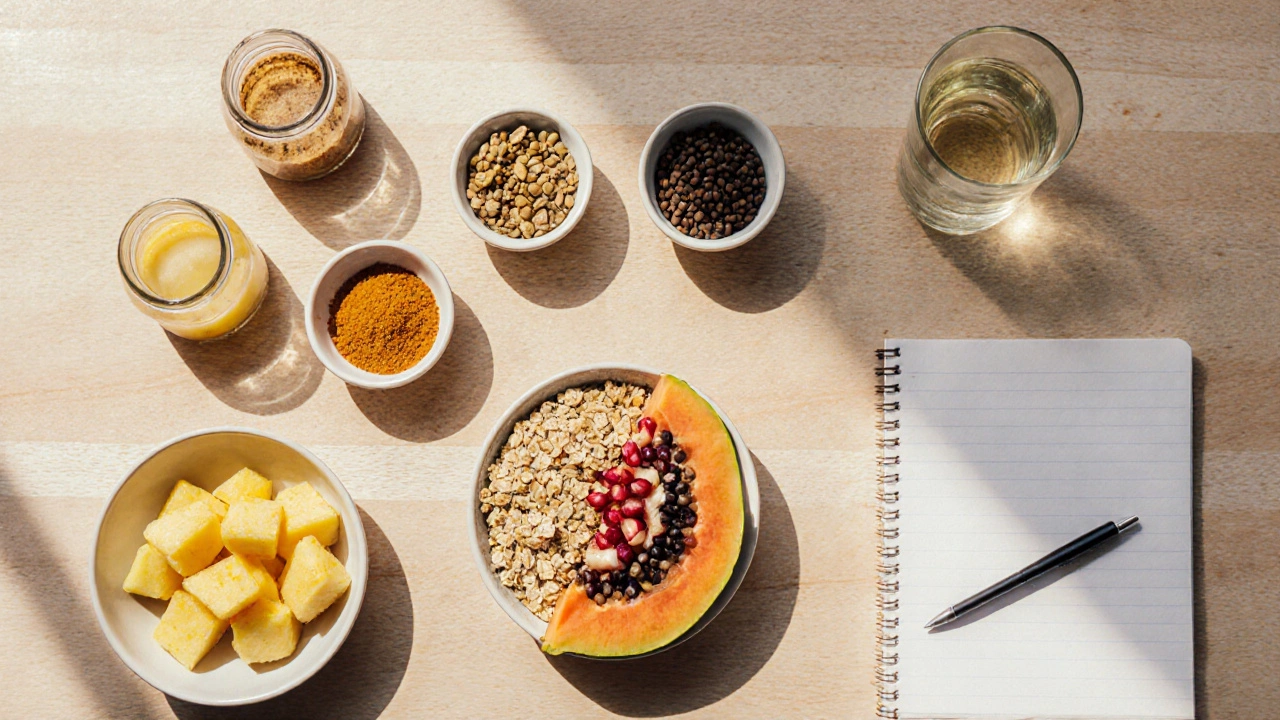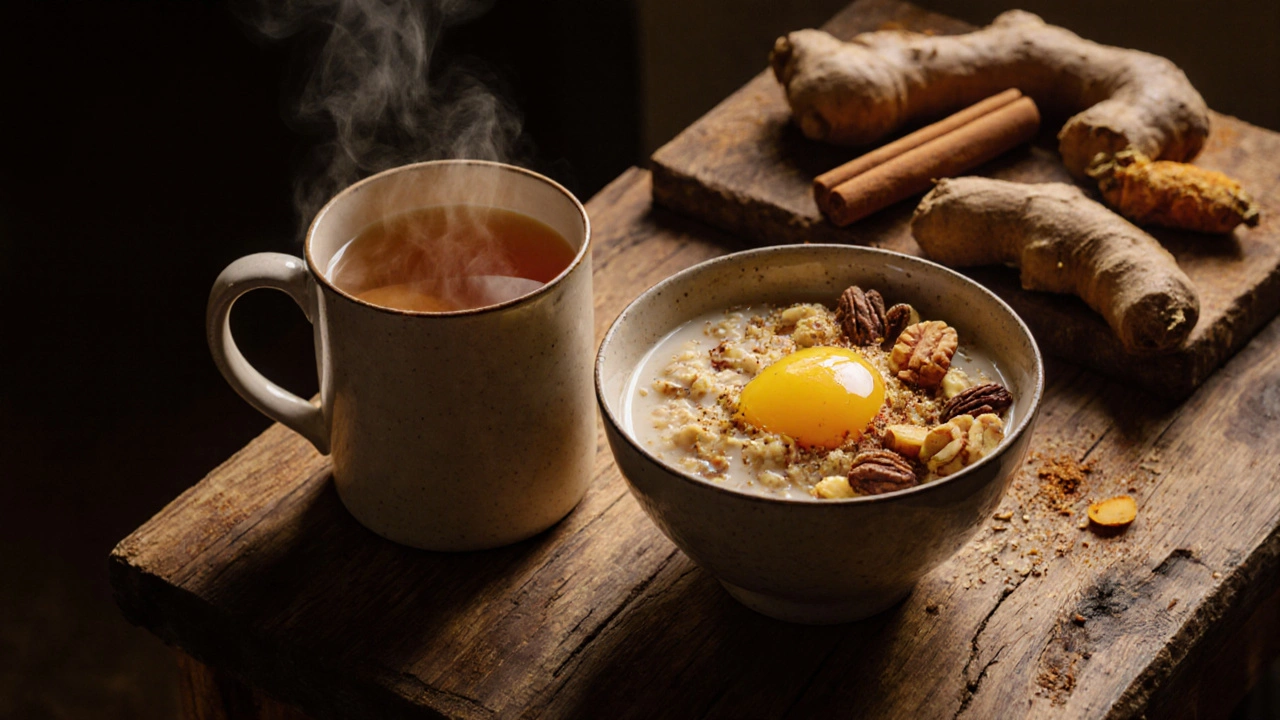Dosha Quiz: Find Your Ayurvedic Breakfast Type
What's Your Ayurvedic Breakfast Type?
Take this quick quiz to discover your dominant dosha and get personalized breakfast recommendations tailored to your unique constitution.
How do you typically feel first thing in the morning?
What's your typical digestion like?
What temperature foods do you prefer?
What do you crave in the morning?
How do you handle stress?
Your Dominant Dosha:
Why Your Dosha Matters
Ayurveda teaches that your dosha influences how your body processes food, how you feel emotionally, and your overall health. Eating according to your dosha helps maintain balance and optimal digestion.
Eat within 1 hour of waking to ignite your digestive fire (Agni).
Sample Dosha Breakfasts
Vata Breakfast
Warm oatmeal with ghee, nuts, and dried fruit
+ Ginger tea to calm nervous energy
Pitta Breakfast
Quinoa porridge with coconut milk and berries
+ Mint tea to cool excess heat
Kapha Breakfast
Millet khichdi with vegetables and turmeric
+ Ginger-lemon water to stimulate digestion
Ayurveda is an ancient Indian system of medicine that emphasizes balance of the body, mind, and spirit through diet, lifestyle, and herbs. One of the core ideas is that the first meal of the day sets the tone for digestion, energy, and dosha harmony. In this guide we’ll break down exactly what you should eat in the morning according to your Dosha type, how to support Agni (digestive fire), and practical tips you can start using today.
Understanding the Dosha‑Based Breakfast
Ayurveda classifies every person into one of three primary constitutional types - Vata, Pitta, or Kapha. Your dominant dosha determines which flavors, textures, and temperatures support optimal digestion. The morning meal should:
- Warm the stomach and ignite Agni
- Balance the dominant dosha’s excesses
- Provide steady energy without causing spikes or crashes
When the breakfast aligns with your constitution, you’ll notice better focus, less cravings, and smoother bowel movements throughout the day.
General Principles for All Doshas
Before diving into dosha‑specific menus, keep these universal rules in mind:
- Eat within an hour of waking - the body’s digestive fire is strongest then.
- Prefer warm‑cooked foods over raw or cold items; heat activates enzymes.
- Include a touch of sweet, sour, or salty taste to stimulate appetite.
- Avoid excessive caffeine, refined sugar, and fried foods first thing.
- Stay hydrated with warm water or herbal tea; skip ice‑cold drinks.
These basics work for anyone, regardless of season or age.
Breakfast Options for Vata Types
Vata is light, dry, and cold. Morning meals should be grounding, oily, and warming.
- Warm oatmeal cooked with milk, topped with ghee, nuts, and dried fruit.
- Steamed or sautéed vegetables such as carrots, sweet potatoes, and spinach with a pinch of cumin.
- Mashed ripe banana mixed with a spoonful of Ghee and a sprinkle of cinnamon.
- Herbal tea made from ginger or fennel - both help calm Vata’s nervous energy.
Vata benefits from a slightly larger breakfast (about 25‑30% of daily calories) because its metabolism tends to be fast and erratic.

Breakfast Options for Pitta Types
Pitta is hot, sharp, and oily. Morning foods should be cooling, mildly spiced, and slightly sweet.
- Quinoa porridge with coconut milk, fresh berries, and a dash of cardamom.
- Cooked apples or pears with a hint of honey and a pinch of cloves.
- Whole‑grain toast topped with avocado and a sprinkle of black salt.
- Cooling herbal tea - mint, coriander, or licorice root works well.
A moderate portion (about 20‑25% of daily calories) keeps Pitta from overheating while still feeding the active digestive fire.
Breakfast Options for Kapha Types
Kapha is heavy, moist, and cool. Morning meals need to be light, stimulating, and a bit bitter or pungent.
- Millet or buckwheat khichdi with vegetables, a teaspoon of mustard seeds, and a splash of lemon juice.
- Spiced lentil soup (moong dal) with ginger, turmeric, and a pinch of black pepper.
- Fresh fruit salad featuring pineapple, papaya, and pomegranate - all natural appetite boosters.
- Warm ginger‑lemon water to jump‑start metabolism.
Kapha should keep breakfast light (15‑20% of daily calories) to avoid sluggishness.
Seasonal Adjustments
Ayurveda also respects the changing seasons. Here’s a quick cheat‑sheet:
| Season | Vata | Pitta | Kapha |
|---|---|---|---|
| Winter | Extra ghee, warm milks, spiced porridge | Moderate heating spices, avoid too many oily foods | Include warming herbs like cinnamon, limit dairy |
| Summer | Cooler fruits (berries), but still warm base | Emphasize cooling foods - coconut, cucumber | Light soups, avoid heavy grains, add black pepper |
| Monsoon | Dry roasted nuts, avoid excess moisture | Gentle spices, keep foods easy to digest | Warm stews with ginger, keep mouth dry |
These tweaks make sure your breakfast stays in sync with both your dosha and the weather.

Supplements and Ayurvedic Superfoods
While whole foods are the foundation, a few classic Ayurvedic items can boost morning nutrition:
- Chyawanprash - a jam‑like herb mix rich in antioxidants; a teaspoon after breakfast supports immunity.
- Triphala powder - a gentle laxative; a pinch mixed into warm water can aid detox for Kapha.
- Turmeric milk (golden milk) - anti‑inflammatory; ideal for Vata and Pitta on cooler mornings.
- Organic honey - a quick source of simple sugars; limit to one teaspoon for Pitta.
Use these sparingly; the goal is to enhance, not replace, a balanced meal.
Practical Tips to Start Tomorrow
- Identify your dominant dosha (simple online quizzes or a quick consult with an Ayurvedic practitioner).
- Plan your breakfast the night before - write down the ingredients you’ll need.
- Prep base items in bulk: cook a large pot of millet, quinoa, or oats; store in the fridge.
- Keep a small jar of ghee, a bottle of ginger‑lemon water, and a stash of spice mixes handy.
- Track how you feel after three days - note energy levels, digestion, cravings. Adjust spices or portion sizes accordingly.
Consistency is key. Within a week you’ll start sensing smoother digestion and steadier energy.
Common Mistakes to Avoid
- Skipping the warm breakfast entirely - cold foods blunt Agni.
- Eating the same heavy dish every day - leads to dosha imbalance.
- Adding too much sugar or artificial sweeteners - they disrupt gut flora.
- Relying solely on processed “Ayurvedic” snacks from the market - they often contain preservatives and excess salt.
Stick to fresh, minimally processed ingredients and you’ll reap the real benefits of Ayurvedic nutrition.
Can I mix foods from different dosha recommendations?
Yes, but keep the dominant dosha’s principles front‑and‑center. A small amount of cooling fruit in a Vata‑focused oatmeal is fine; just don’t overload the dish with opposite‑type flavors.
Is it okay to have coffee in the morning?
Coffee is highly stimulating and can aggravate Pitta and Kapha. If you love it, limit to one small cup and pair it with a light, warming snack - for example, a piece of ginger‑spiced toast.
How much ghee should I use daily?
For most adults, 1-2 teaspoons of ghee spread across meals is sufficient. Vata can go up to 2 tsp per breakfast, while Pitta and Kapha should stay at 1 tsp.
Do I need to fast before breakfast?
No. In Ayurveda, the day begins with the first meal. Skipping breakfast weakens Agni and can lead to irregular appetite later.
Can children follow these dosha‑based breakfasts?
Children’s constitutions are usually Vata‑dominant, so warm, nourishing foods are beneficial. Keep portions small and avoid overly spicy or bitter tastes.





